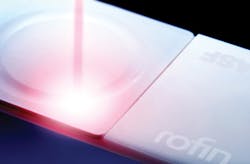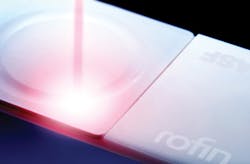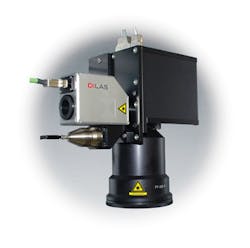Laser welding facilitates fusion of polymers
Process offers true hermetic sealing with minimal stress
DAVE GIRARDOT
Aside from conventional welding methods, laser fusion of plastics or polymers has established itself as a long-proven bonding method in many industries. This clean process offers numerous advantages to users, and enables fusion of sensitive assemblies. With few exceptions, laser fusion of polymers is a transmission process in which the components to be welded are overlapped. As shown in FIGURE 1, the upper joining component transmits the laser radiation, which is absorbed by the lower part and then melted. Heat transfer also melts the upper layer and produces a weld between the parts. The laser transmission properties of the components to be welded are therefore important in this method.
Diode lasers typically used for the fusion of polymers emit a beam with a wavelength between 800 and 1000nm. Most non-colored thermopolymers have good transmission properties in this wavelength range.
An absorbing material such as carbon black can be added to the base material, and special additives can be incorporated into the mix as well. Various color combinations are possible that are transparent to light but absorb at the wavelength of the laser, or strongly absorb but also transmit at the wavelength.
Process advantages
Most laser joining competes heavily with conventional joining methods, offering many process advantages. In particular, the ability to control the energy input into the joining zone has been found to be a significant advantage for many assemblies. Typical advantages include:
- True hermetic sealing;
- Minimal mechanical and thermal stress;
- Stable, proven, and very flexible process;
- Completely particle- and debris-free;
- An internally protected joint;
- Minimal melt ejection;
- No additional materials required; and
- Very high quality and durability of the weld.
Quality and process controls
As with other joining methods, the issue of quality control also arises in laser fusion. How can one confirm quality during the fusion process and/ or separate good parts from bad parts? How can the number of rejected parts be reduced by appropriate process control?
One opportunity for quality assessment, which is also used in other welding methods, is to measure the variation of a parameter along a set fusion path. Such a path can be realized by using a galvanometer scanner that drives the laser beam around a fixed, closed path quickly (FIGURE 2).
The laser beam is rapidly deflected over a programmable fusion contour, and the contour is melted almost simultaneously. By using a mechanical clamping device and lightly pressing the assembly components together, the molten material collapses to a defined distance and can be measured. If the joining partners are compatible and weldable, one can equate the collapse with a quality weld. If the parameters have not been met, the fusion seam quality may not be sufficient—so the part could be rejected.
An alternative way to assess the fusion quality is by using a remote pyrometer measurement of the molten material during the fusion process. Processing heads with an integrated pyrometer allow rapid control of the fusion temperature and the detection of fusion defects. The advantage of temperature control during the fusion process (closed-loop process) is clear when the components to be welded show a certain inhomogeneity with respect to their optical properties. Such inhomogeneities can occur when the components are reinforced with glass fibers. For example, these inhomogeneities can be compensated for with automatic laser power control, maintaining the required temperature.
While a defective weld area cannot be compensated for by the pyrometer control, a sudden increase in the temperature signal (for example, caused by a contaminated or a poor or non-existing mechanical contact between the two components) may be indicated. Likewise, the pyrometer will detect if the required fusion temperature is not achieved; e.g., by lack of laser power. If the upper and lower temperature limits—defined within software—are exceeded, the affected components can be rejected. An individual process number for each single weld allows mapping control.
Polymer fusion
Laser fusion of polymers is an established process that is increasingly used in a range of different industries, and is displacing the traditional joining methods. In medical device manufacturing, for instance, cleanliness is absolutely mandatory.
Laser fusion is particularly well established in the automotive supply industry, where parts are equipped with sensitive electronic components or guide and contain fluid. In these and other cases, laser beam fusion is the method of choice. In combination with process control, the diode laser will continue to make its way into many future applications.
Clear-to-clear polymer fusion
In the recent past, fusion of clear polymers required special absorbers that were often expensive and added processes to the equation. The onset of higher wavelength lasers has removed the requirements for absorbers in many clear fusion applications.
In transparent polymer fusion, higher wavelength lasers are used, which interact differently with the polymer than traditional 800–1000nm lasers used in clear polymer fusion. Some of the laser energy is still transmitted through a clear thermoplastic, but at this wavelength minor absorption still occurs in the part. Enough energy is absorbed to heat the polymer in the fusion zone and create the desired result.
Well known in the laser world, the laser energy will be absorbed at each of the surfaces of the polymer being fused. Typically in these applications, there are four surfaces where absorption will take place. These include the upper surface, the two joining surfaces, and the lower surface or exit side. Because the interface of the joint is composed of multiple planes, the majority of the absorption in clear-to-clear welding occurs here providing a perfect environment for joining clear thermoplastics without absorber additives.
DAVE GIRARDOT ([email protected]) is North American Sales Manager for Rofin-Sinar, Plymouth, MI; www.rofin-inc.com


